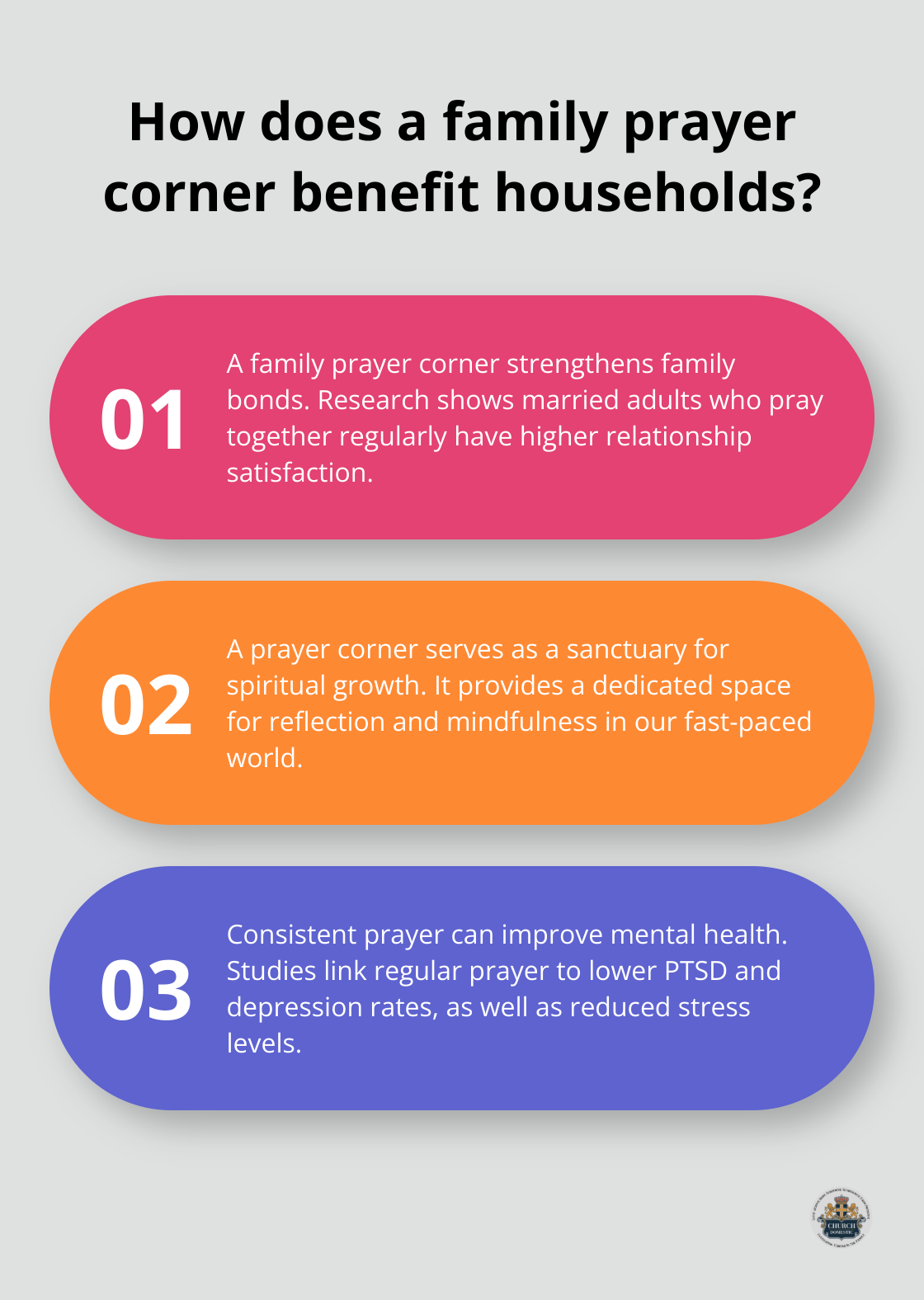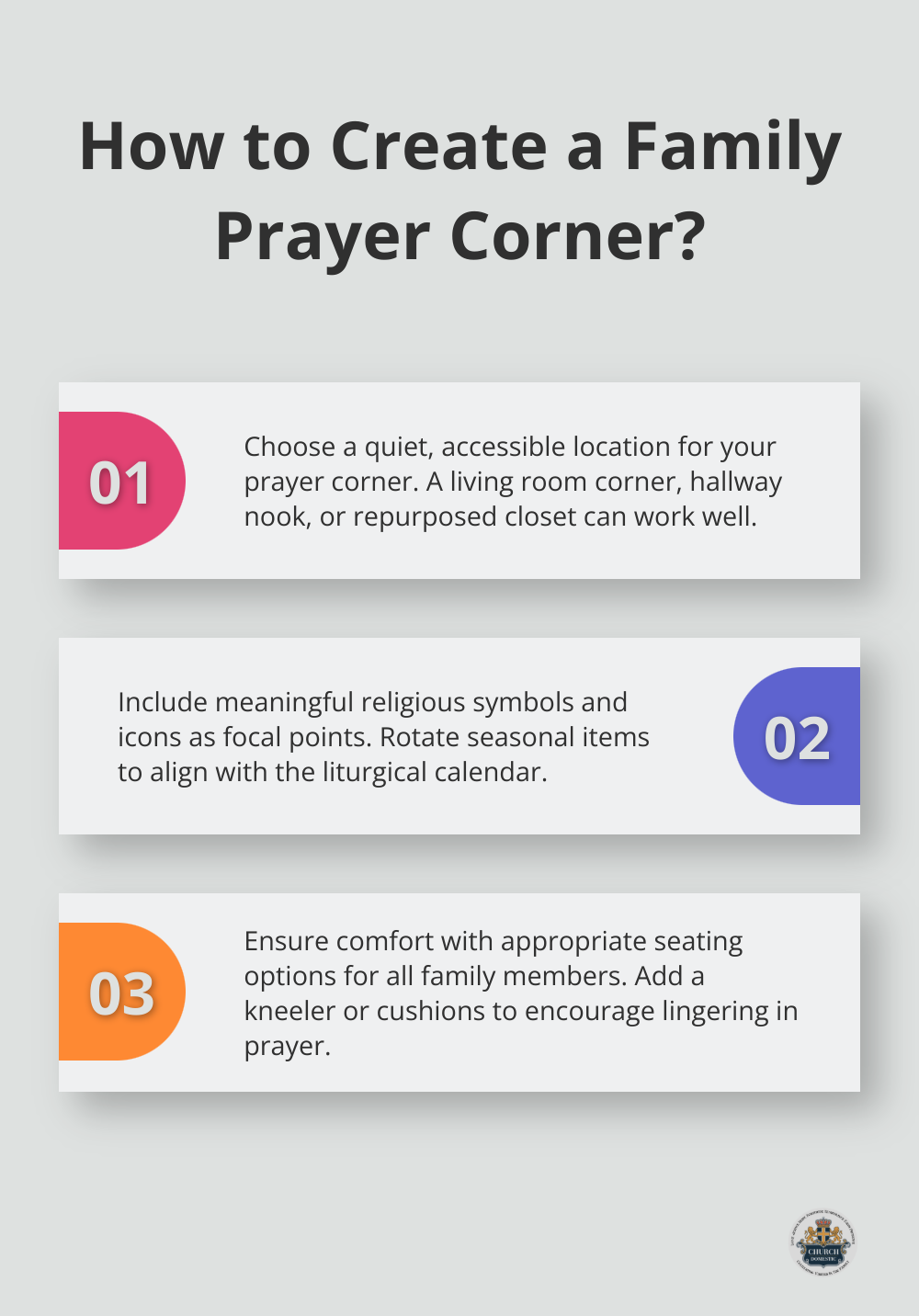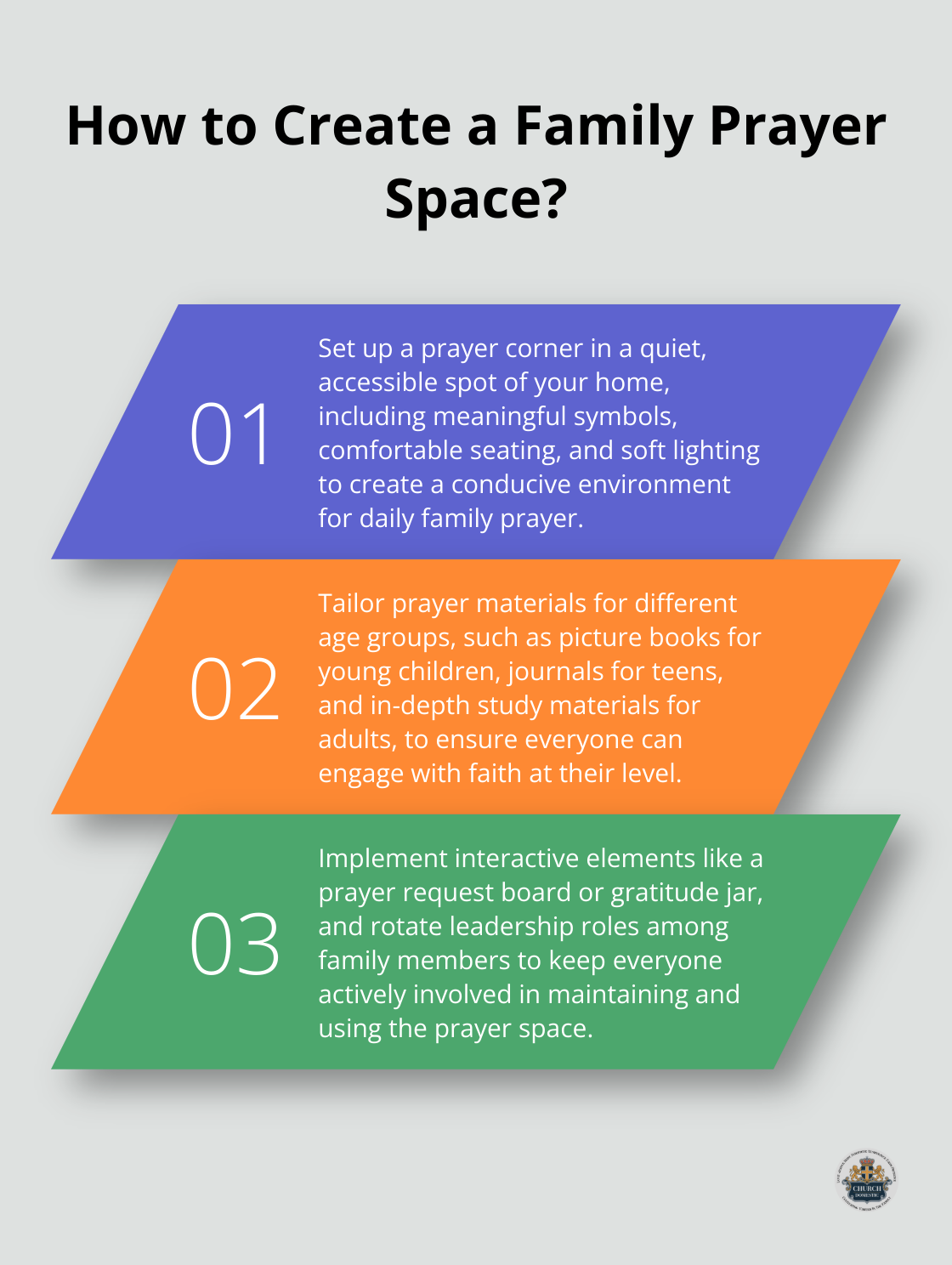At Church Domestic, we believe a home altar can transform your living space into a sacred sanctuary. Creating this spiritual focal point together as a family strengthens bonds and deepens faith.
In this guide, we’ll walk you through the process of building a meaningful home altar that reflects your family’s unique spiritual journey. From choosing the perfect location to selecting meaningful objects, we’ll provide practical tips to help you create a space for prayer, reflection, and connection.
Where Should You Place Your Home Altar?
Creating a home altar is a personal and spiritual endeavor. The location you choose will impact your family’s engagement with this sacred space. Let’s explore how to select the perfect spot for your altar.
Find a Quiet Corner
Your home altar should be in a peaceful area where family members can pray and reflect without interruption. If you’re wanting a quiet spot, yet have lots of traffic in the living room, you may want to choose a quieter room. The size of your altar is up to you. A spare bedroom, a nook in the master bedroom, or even a dedicated corner in a home office can work well. The key is to choose a place where you can maintain a sense of reverence and focus.
Harness Natural Light
Natural light can enhance the spiritual atmosphere of your altar space. If possible, position your altar near a window. The changing light throughout the day can create a dynamic and inspiring environment for prayer and meditation. However, be mindful of direct sunlight that might damage religious artifacts or cause candles to melt prematurely (a common issue for many altar keepers). Soft, filtered light is ideal for creating a serene ambiance. A personal altar is essentially a sacred space in your home that serves as a “spiritual center” where you can focus on being your highest self.
Minimize Distractions
To make your altar a true sanctuary, it’s important to minimize distractions in the surrounding area. Remove electronic devices, clutter, and anything that might draw attention away from your spiritual practice. Consider using a room divider or a decorative screen to separate the altar space from the rest of the room if you’re working with limited space. This physical barrier can help create a mental shift when you enter your prayer area.
Consider Feng Shui Principles
While not essential, some families find it helpful to incorporate Feng Shui principles when placing their home altar. In Feng Shui, the northeast corner of a room is often considered auspicious for spiritual activities. This area is associated with personal growth and wisdom. However, don’t feel bound by these guidelines if another location feels more natural to you.
Make It Accessible
The perfect location for your home altar is one that feels right for your family. It should be a place where you naturally gravitate for moments of quiet reflection and prayer. Accessibility is key – if the altar is tucked away in a hard-to-reach spot, it’s less likely to be used regularly. Try to strike a balance between privacy and ease of access.

As you consider these factors, you’ll create a sacred space that becomes an integral part of your family’s spiritual life. With the location settled, it’s time to think about what to place on your altar. Let’s explore the essential elements that will make your home altar meaningful and personal.
What Should You Put on Your Home Altar?
Creating a meaningful home altar requires more than arranging objects. It demands a thoughtful curation of items that reflect your family’s spiritual journey and values. We at Church Domestic have observed how carefully selected elements transform a simple altar into a powerful focal point for prayer and reflection.
Symbols of Faith
Begin with the cornerstone of your faith. For many, this might be a cross or crucifix. The size and style should complement your space and resonate with your family’s aesthetic. A hand-carved wooden cross offers a rustic feel, while a sleek metal design provides a modern touch. If you practice a different faith tradition, choose a central symbol that represents your beliefs (such as a statue of Buddha or a Star of David).
Personal Touchstones
Add items that hold special meaning for your family. This could include a rosary passed down through generations, a prayer shawl gifted by a loved one, or even a small box containing written prayers or intentions. These personal items infuse your altar with emotional significance and serve as reminders of your spiritual heritage.

A study by the Pew Research Center found that the frequency of prayer varies significantly among religious groups, with some groups praying daily at rates as high as 90%. Personal items on your altar create a tangible connection to this practice, which increases the likelihood of family members engaging in regular prayer.
Sacred Texts and Devotionals
Place religious texts that guide your faith on your altar. This could be a family Bible (perhaps one used to record important family events). Add prayer books, devotionals, or spiritual writings that inspire your family. Rotate these texts seasonally or based on your current spiritual focus to maintain a dynamic and relevant altar.
Candles and Incense
Lighting plays a crucial role in creating a sacred atmosphere. Candles provide soft illumination and symbolize the divine presence. Choose unscented candles for a pure, focused environment or opt for scented ones that enhance your spiritual experience. Incense, if used, adds another sensory dimension to your altar space.
According to the National Candle Association, more than 1 billion pounds of wax are used in producing candles sold each year in the U.S. When selecting candles for your altar, try natural wax options like beeswax or soy for a cleaner burn and to avoid potential allergens.
Nature’s Offerings
Incorporate elements of nature to represent God’s creation on your altar. Fresh flowers, seasonal fruits, or small potted plants add life and color. A bowl of water can symbolize purity and renewal. Change these natural elements regularly to reflect the passing seasons and maintain a vibrant altar.
Family Contributions
Ask each family member to contribute something to the altar. Children might add their own artwork depicting their understanding of faith. Teenagers could choose quotes or small objects that represent their spiritual journey. This inclusive approach ensures that everyone feels connected to the family’s spiritual center.
Your home altar should evolve with your family’s spiritual growth. Don’t hesitate to make changes, add new elements, or remove items that no longer serve your spiritual needs. The goal is to create a space that draws your family together in faith and reflection. Now that we’ve explored what to put on your altar, let’s discuss how to involve the whole family in this meaningful process.
How to Involve Your Family in Creating the Altar
Start with a Family Meeting
Call everyone together to discuss the altar’s purpose. Explain its importance in your spiritual life and how it will serve as a focal point for family prayer and reflection. This meeting provides an opportunity to address any questions or concerns family members might have.

Family religious practices such as family prayer promote religious internalization and impact adolescent spiritual development. Use this meeting to highlight how the altar will support your family’s spiritual growth.
Assign Meaningful Roles
Give each family member a specific responsibility in creating the altar. One person could select religious symbols, while another chooses candles or incense. This ensures everyone feels invested in the process.
Parents can guide younger children by offering them age-appropriate tasks. A five-year-old might pick out a special stone or shell to represent God’s creation, while a teenager could research and suggest meaningful quotes or scripture passages to display.
Encourage Creative Contributions
Children often express their spirituality through art. Set aside a dedicated space on your altar for rotating displays of your children’s faith-inspired creations. An important part of the domestic church is creating a place to gather together for daily family prayer.
For older children and teens, consider incorporating their digital skills. They could create a slideshow of family photos or religious imagery to display on a small digital frame as part of the altar.
Share the Stories Behind Each Item
As you add elements to your altar, take time to discuss their significance. If you include a family heirloom, share its history. For objects collected during travels, recount the memories associated with them. This storytelling process helps cement the emotional and spiritual connections to your altar.
Establish a Rotation System
To keep everyone engaged long-term, create a schedule for maintaining and refreshing the altar. Assign weekly or monthly tasks like changing flowers, updating prayer intentions, or selecting new devotional readings. This ongoing involvement ensures the altar remains a living part of your family’s spiritual practice.
Final Thoughts
A home altar transforms your living space into a sacred sanctuary. It reflects your family’s spiritual journey and provides a dedicated area for prayer and reflection. This special place strengthens family bonds, encourages faith discussions, and creates shared spiritual experiences.

Your home altar should evolve with your family’s spiritual growth. Update it regularly with new elements that reflect your current spiritual focus. Remove items that no longer resonate to keep the altar vibrant and meaningful for everyone.
We at Church Domestic believe in the power of nurturing your family’s spiritual life at home. A home altar helps create a domestic church where faith thrives daily. Embrace this practice to foster a legacy of faith that impacts generations to come.